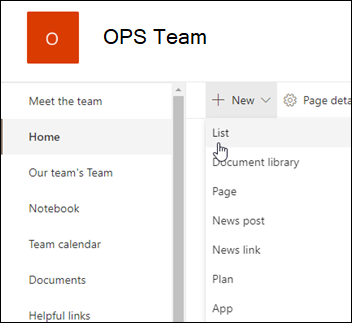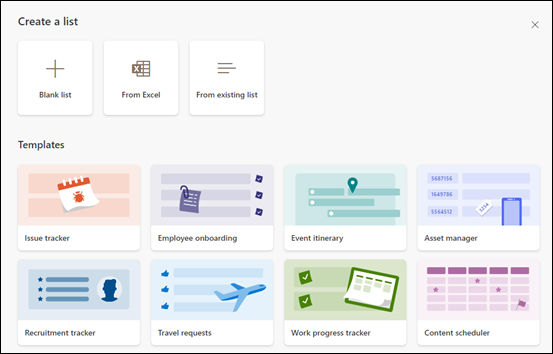
Sharepoint Allows You to Create What Type of List? You Must Know
SharePoint allows you to create various types of lists such as custom lists, task lists, issue tracking lists, and more. Each list template is designed to cater to specific data management needs, making it easier for users to organize and track information effectively.
Whether you need to manage contacts, calendar appointments, tasks, or any other type of data, SharePoint provides the flexibility to create and customize lists according to your requirements. By utilizing SharePoint’s list creation capabilities, users can enhance data organization, collaboration, and workflow management within their SharePoint environment.

Credit: support.microsoft.com
Contents
SharePoint allows you to create various types of lists to organize and manage your data effectively. Whether you need a custom list, a task list, or an issue tracking list, SharePoint has got you covered. Let’s take a closer look at each of these list types:
Custom List
A custom list is a versatile option that allows you to create a list tailored to your specific needs. Whether you want to keep track of project milestones, inventory, or customer information, a custom list can be customized with different columns, data types, and views to suit your requirements. It gives you the flexibility to define your own fields and modify the layout as needed. You can add text, numbers, dates, attachments, and even create lookup columns to establish relationships between lists. With a custom list, you have full control over the structure and organization of your data.
Task List
A task list in SharePoint is a perfect tool for managing projects and assignments, tracking progress, and assigning tasks to team members. With a task list, you can create individual tasks, set due dates, assign responsible parties, and add priority levels. You can also create subtasks and define dependencies between them. Additionally, you can set up email notifications and reminders to keep everyone informed and on track. The task list view provides different filtering and sorting options, allowing you to easily monitor and prioritize tasks. Whether you’re managing a small project or a complex workflow, the task list helps streamline your team’s activities.
Issue Tracking List
An issue tracking list is an invaluable tool for documenting and managing issues or problems that arise during a project or within an organization. It allows you to record the details of an issue, such as the description, severity, assigned owner, and resolution status. You can also track the progress of each issue, add comments, and attach relevant files or screenshots for better clarity. With the issue tracking list, you can create custom views to filter and display open issues, resolved issues, or even generate reports based on specific criteria. This helps ensure that issues are promptly addressed, monitored, and resolved, leading to improved efficiency and customer satisfaction.
SharePoint offers these three essential list types and more, each designed to facilitate effective data management and collaboration within your organization. Whether you need a custom list to suit your unique requirements, a task list to manage projects and tasks, or an issue tracking list to track and resolve issues, SharePoint has the right list template for you. Empower your teams with the power of SharePoint lists and watch your productivity soar.
SharePoint is a powerful platform that allows you to create various types of lists to store, share, and manage your data. By leveraging SharePoint’s list feature, you can have better control over your information and streamline your business processes. In this section, we will explore how to create a SharePoint list, starting with using templates and providing a step-by-step guide.
Using Templates
SharePoint offers a wide range of list templates that serve as a great starting point for your specific data management needs. These templates include “Custom List,” “Task List,” “Issue Tracking,” and more. Each template is designed to cater to a specific type of data, ensuring that you find the most suitable option for your requirements.
To create a list using templates, follow these steps:
- From your SharePoint site’s home page, navigate to the desired site where you want to create the list.
- Click on the “Settings” gear icon and select “Add an app.”
- In the search box, type the name of the template you want to use, such as “Task List.”
- Press Enter, and SharePoint will display a list of available templates matching your search query.
- Select the desired template and click “Create.”
- Give your list a name or title and click “Create.”
Step-by-step Guide To Creating A List
If you prefer to create a SharePoint list from scratch without using templates, you can follow this comprehensive step-by-step guide:
- From your SharePoint site’s home page, navigate to the desired site where you want to create the list.
- On the site contents page or the SharePoint site home page, click on the “+ New” button.
- Select “List” from the dropdown menu.
- On the “Create a list” page, choose one of the options that best suits your data requirements.
- Enter a name for your list and provide a description if needed. Click “Create” to proceed.
- Configure the list settings according to your preferences, such as enabling versioning, enforcing unique values, or setting up validation rules.
- Define the columns for your list by specifying their names, types, and additional properties.
- Customize the appearance and functionality of your list by applying views, setting up workflows, or adding web parts.
- Once you’ve tailored the list to your specific needs, save your changes and start populating the list with data.
By following these steps, you can easily create a SharePoint list either using templates or by building it from scratch. Harness the power of SharePoint’s list feature to organize and manage your data effectively.
SharePoint lists offer a structured and efficient way to manage data and records. You can easily organize information, track changes, and collaborate on various documents.
With SharePoint lists, you can customize the formatting of your data to suit your specific requirements. Moreover, workflows can be automated to streamline processes and ensure smooth operations.

Credit: powerusers.microsoft.com
SharePoint lists provide a versatile way to organize, store, and manage data within a collaborative environment. By leveraging the capabilities of SharePoint lists, organizations can achieve enhanced data organization, improved collaboration, and accessibility. Below are the key benefits that SharePoint lists offer:
Effective Data Organization
SharePoint lists allow for structured and efficient data organization, enabling users to create various types of lists tailored to their specific needs. Whether it’s a custom list, task list, issue tracking, or any other type, SharePoint provides robust templates that serve as a starting point for list creation. These templates facilitate seamless management of different data types, ensuring that information is logically structured and easily accessible.
Enhanced Collaboration And Accessibility
With SharePoint lists, teams can collaborate seamlessly, streamlining the sharing and management of data. The platform’s capabilities enable users to define workflows, access controls, and different formatting options, empowering efficient data tracking and management. This level of access and collaboration fosters enhanced productivity and transparency within the organization, driving better decision-making and overall efficiency.
Frequently Asked Questions
SharePoint allows you to create various list templates such as “Custom List,” “Task List,” and “Issue Tracking,” to suit specific data management needs. You can start with these templates as a starting point for your data organization.
Yes, you can create a To Do list in SharePoint. Use the “Tasks” template to start and manage your task list easily.
SharePoint lists are used to track and manage data and records, such as contacts, tasks, and calendar appointments. They offer different formatting options, workflows, and access controls to suit your data management needs. You can create various types of lists using templates provided by Microsoft, such as “Custom List,” “Task List,” and “Issue Tracking.
What Can You Create On Sharepoint?
SharePoint allows you to create various types of lists such as custom lists, task lists, issue tracking lists, and more. Each list template is designed to suit specific data management needs. You can easily create and manage contacts, calendar appointments, tasks, and other types of information using SharePoint lists.
Conclusion
SharePoint offers various list templates like Custom List, Task List, and Issue Tracking. Each is tailor-made for specific data needs. Choose a template that aligns with your data management requirements. Utilize SharePoint lists to store, organize, and manage various types of information effectively.



